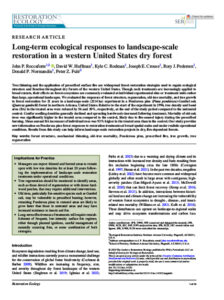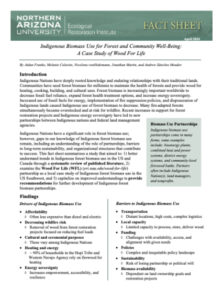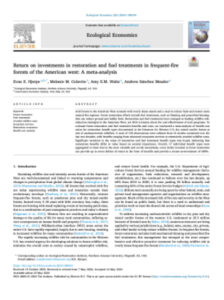Ecological Restoration Institute
Our Mission
ERI serves diverse audiences with objective science and implementation strategies that support ecological restoration and climate adaptation on Western forest landscapes.
Long-term ecological responses to landscape-scale restoration in a western United States dry forest
Tree thinning and prescribed surface fire are common forest restoration strategies in the dry forests of the western United States. These treatments are often assessed at small scales rather than across large areas. This study evaluated forest structure, regeneration, old-tree mortality, and tree growth over 21 years in a large (2114 ha) Ponderosa pine-Gambel oak forest in northern Arizona. By the end of the study, tree density and basal area in the treated area were reduced by 56% and 38%, respectively, compared to the untreated control. Conifer seedling densities generally declined while hardwood sprouting increased post-treatment. Old oak tree mortality was higher in the treated area, likely due to fire injury. The mean annual basal area increment of individual trees was 93% higher in the treated area than in the control. These findings offer valuable insights for large-scale restoration efforts in dry, fire-dependent forests.
Return on investments in restoration and fuel treatments in frequent-fire forests of the American west: A meta-analysis
Arid forests in the American West are overly dense and need fuel reduction and fire regime restoration. Forest restoration efforts, such as thinning and prescribed burning, aim to reduce wildfire risks. Despite their importance, the cost-effectiveness of these programs is not well understood. This study conducted a meta-analysis of 120 observations from 16 studies over the past two decades to evaluate the benefits and costs of forest restoration and fuel treatments. Results showed significant variation in benefits, from enhanced ecosystem services to avoided wildfire costs. In high-value, at-risk watersheds, every dollar invested in restoration yielded up to seven dollars in benefits, achieving a 600% return on investment.
Research Topics
Research Sites
This map provides an overview of the Ecological Restoration Institute’s research sites across Arizona, Colorado and New Mexico.
- A “pin” icon in the upper right-hand corner of the map allows you to toggle between research sites that focus on 3 areas:
-
- Landscape Monitoring and Research
- Long-Term Ecological Assessment and Restoration Network (LEARN)
- Wildfire Effects
- Click on a specific pin location (orange, green or blue) on the map to learn more about the research and access literature published from data collected at the site.
- Use Ctrl + scroll to zoom in on the map.



